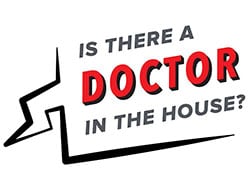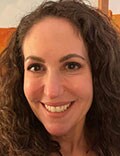
Emergencies happen anywhere, anytime, and sometimes medical professionals find themselves in situations where they are the only ones who can help. Is There a Doctor in the House? is a Medscape series telling these stories.
I was doing a road trip through California and Nevada with my 9-year-old daughter, Amelia, and my sister, Naomi. The only request I had on the trip was to see Death Valley, so we took a Jeep tour.

Dr Rebecca Hirsch
Death Valley is majestic. It is one of the driest places in the world, stark and arid and remote, but so beautiful. You think you’re on the moon.
Our guide stopped to show us a place where an earthquake had sheared off the side of a hill. My sister stayed in the Jeep, and she saw a cyclist go around us on the two-lane road heading toward Badwater Basin. We got back in, and as soon as we rounded the curve of the hill, we saw the cyclist down on the right-hand side of the road.
A bunch of people were standing around looking concerned. I yelled to the tour guide, “Stop! I’m a doctor!” I jumped out of the Jeep and ran over to him. I asked the group, “Are any of you medically trained?” They all said, “no.” I said, “Okay, I’m taking over.”
The cyclist was on his right side, bleeding profusely from his head and face. He was moaning but unconscious and clearly concussed. We needed to call 911, but there was no cell coverage. Our tour guide had a satellite phone, so she called the visitor center and they activated EMS.
Now here’s the fun part: I’m a psychiatrist. And as a psychiatrist, my biggest fear is that something horrible might happen and all I can do is say, “Well, how do you feel about falling off your bike and hitting your head?”
But as students and residents, we do thousands of hours of training. We rotate through everything. Those memories of being in the emergency room all came back. I remembered my ABCs. I remembered to stabilize the C spine, check for blunt trauma, all of those things.
While that was going on, the cyclist started to come to. He was moving about, and I got really concerned about head and neck injury. I held his head and got everybody to help turn him in a straight line onto his back so that his head moved with his body.
I unzipped his jersey and looked for any obvious signs of blunt trauma, any huge bruises starting to blossom. Sure enough, he had one on his side, but I wasn’t so worried about that. I thought: If it’s a liver laceration, he’s not going to die. I sort of did a one-handed exam to see if anything was hurting him significantly. Then I just held his head and neck still. Eventually, he came around, and I started talking to him.
His name was Buzz. I asked him orientation questions, and he could give me information. But he was confused. He kept repeating the same questions over and over. “What happened to me? Did I get hit by a car? What’s your name?”
We went through his pockets. There was no ID, but he had a phone on his bike. I asked if we could call his wife ― assuming he was married ― because I needed to get his medical information.
He told us how to find his wife’s number, and when someone read it to the tour guide, I heard the area code: 925. That’s my area code.
I said, “Where do you live?”
He said, “I live in Dublin.”
I said, “I live in San Ramon. Where you do get your care?”
“Pleasanton.”
So we were basically neighbors. “I work at Kaiser Pleasanton,” I said. “I’m not going to charge you a copay for this.”
As injured as he was, he had a great sense of humor. When I was unzipping his jersey, he asked, “Is somebody doing sexy things with me?” I was like, “No, Buzz. Nobody’s doing anything sexy right now.”
I kept kneeling there, holding his head, trying to calm him and convince him to stay still. I couldn’t take his helmet off until he got a cervical collar on, so I couldn’t assess if he had a head laceration. Protecting his neck was more important. He could move all four extremities though, so that was a positive sign.
About 20 minutes into it, somebody came up with a pair of gloves. But by then I was already covered in blood. Buzz had lacerated his tongue badly, and his mouth was full of blood. He kept saying, “Can I turn my head and spit?” And I kept saying, “No, but we’ll help you clean it out.” So, we would swab out his mouth with paper towels. He asked me a few times to get up, and I said no.
There were these two young women there who said, “We took a wilderness explorer class. They said that if somebody wants to get up and walk it off, you should let them.” I said, “No. You need to stand over there. I’m in charge here.”
Another guy asked, “Can I give him some water?” I said, “Absolutely not. He already has a mouthful of blood and he might need surgery.”
It took about 50 minutes for EMS to come. I was on the ground with him all that time. My sister was helpful getting things I needed, like a blanket to put under my knees on the rocky pavement. Finally, they came and got a cervical collar on him, and we were able to cut off his helmet and get him onto the stretcher.
By that time, I had taken his medical history, his allergy history, his medication history. I got his name and contact information. I presented it to the EMTs as if I were a medical student to an attending.
Afterwards, I was just standing on the side of the road shaking.
Luckily, someone had soap and water and paper towels so I was able to clean myself up. Then I went back to my 9-year-old who had been sitting in this Jeep for an hour. My sister had been checking on her. My daughter was great. She stayed put. I didn’t want her to see all of that.
Later that day, I was able to search for Buzz on Facebook and Google him. I found his phone number and texted him: Hey, you’re not going to remember anything that happened. I’m the doctor who took care of you. Let me know if you have questions, and please let me know if you’re okay.
When Buzz was alert again, he messaged me and kept me updated. He had a skull fracture and some hemorrhaging into the brain. He had fractured C1, C2, C8, and some of his thoracic vertebrae, and he had a terrible tongue laceration.
He was at University of Las Vegas for 12 days. Then his friends came and took him home to Santa Cruz.
Two months later, I had him over to my house for dinner. He’s such a character. He’s always been involved in athletics and had wiped out on a bike before, but never like this. I think it was hard that he didn’t remember much about the accident. It’s very disorienting to know something terrible happened and have no idea what it was.
If I had allowed those people to move him, things could have been much worse. With a C1, C2 fracture, that might have transected his spinal cord. He could have been quadriplegic or died. A skull fracture and bleeding into the brain are also not things conducive to standing up.
Buzz and I have been chatting ever since. I feel like I’ve made a new friend. We don’t have a conversation without him saying thank you. It’s embarrassing, because I just did what anybody would do. I don’t know a single physician who would walk by and do nothing. It’s just who we are.
Buzz is already back on his bike and just living his best life. He’s the kind of guy who believes that things are going to happen the way they happen. So, live life to the fullest. Don’t take unnecessary risks. But also, don’t stop living.
Rebecca Hirsch, MD, is a psychiatrist with Kaiser Permanente in Pleasanton, California.
Are you a medical professional with a dramatic story outside the clinic? Medscape would love to consider your story for Is There a Doctor in the House? Please email your contact information and a short summary to [email protected].
Read more in the series:
MD Rushes in After Lightning Strikes Four People at White House
Sudden Bedtime Aneurysm Turns MD Couple into Doctor-Patient
Doctor Spots a Gunshot Victim Staggering Down His Street
Doctor Saves Choking Girl at a Baseball Game, Field of Dreams-Style
A Baby Stops Breathing at a Grocery Store – an ICU Nurse Steps In
Read the entire series here.
For more news, follow Medscape on Facebook, Twitter, Instagram, and YouTube
Source: Read Full Article